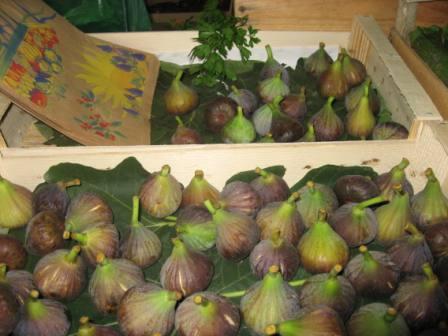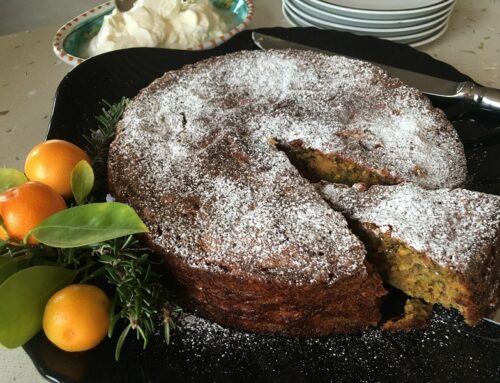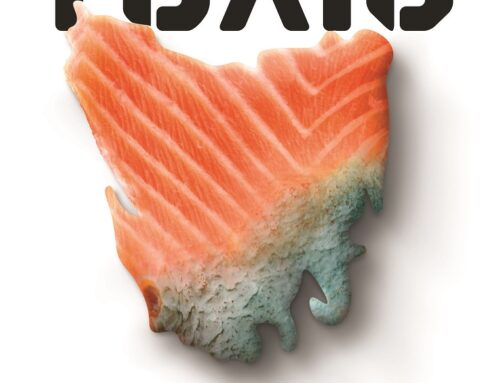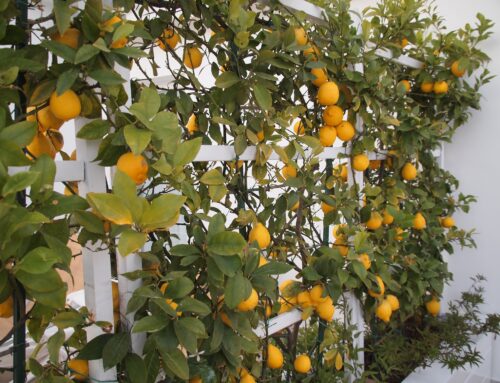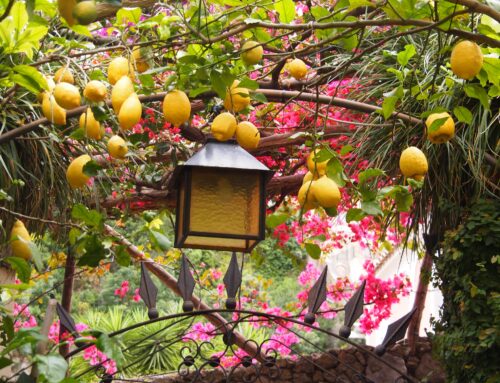All the seasons bring us their special fresh fruits and vegetables. It is nature’s way of ensuring that we have a varied diet. Summer is always much anticipated for its delicious fresh fruits – all the berries, stone fruits, tamarilloes, persimmons, pomegranates and the sweetest and oldest of them all – figs.
The fig is one of the most versatile fruits. They are delicious and nutritious, whether eaten fresh or dried, and work well in savoury and sweet dishes. Interestingly, about 80% of figs are eaten dried; this is probably because fresh figs have a very limited season and are very perishable. They must be left to ripen on the tree long enough to taste and look good, and then once picked must be consumed within 2 to 3 days. Our local figs are a taste sensation as they are picked when full of flavour and with great colour. Figs supplied to the supermarkets must be picked early, before the flavour and colour has been well developed.
When I lived in Kureelpa, ‘The Fig Lady’, Marie Shires, in Shires lane, Woombye, was my local supplier. For the past fifteen years or so, Marie has supplied local restaurants and the community with the most delicious, fresh, juicy figs – figs picked that morning from their trees. Our fig season is between January and April and each year and I really look forward to seeing the ‘fresh fig’ signs around and make the best use of their limited availability. Check the Cooking on the Bay website www.cookingonthebay.com.au for Marie’s fig jam, and figs in syrup recipes.
We use fresh figs as often as possible in our cooking classes. Their delightful, exotic flavour marries surprisingly well with stronger, salty flavours and they often transform a simple dish into a stand-out one.
Try adding fresh figs to a light salad; or fill them with goat’s cheese or gorgonzola, wrap them in prosciutto, sprinkle with sesame seeds and eat fresh as finger food or bake them to create a stunning entrée. Pickled or grilled they are delicious served as an accompaniment to a main meal of duck or chicken. They are luscious and succulent in desserts; in the cooking classes we frequently use them as the fruit base for a clafoutis, we poach them slowly in sugar syrup or in red wine with sugar, orange zest, cinnamon, cloves and black peppercorns; they are sumptuous as a tart, sliced over our frangipane and baked, and delicious simply slit across in quarters and drizzled with honey, then grilled or roasted, and served with ice cream or yoghurt. They are a marvellous addition to a cheese platter next to ripe double brie. Dried figs can be used in cakes, puddings and biscuits, or poached as a dessert. Check Cooking on the Bay www.cookingonthebay.com.au for our fig and frangipane tart recipe and honey roasted fig clafoutis recipe.
The fig tree is deciduous and sub-tropical, and produces best in warm, dry regions, as long as its roots are watered well. Figs grow well on the Sunshine Coast and Gatton, and in the Riverland area of South Australia. Amazingly, in my garden in Brighton, Victoria, I had two prolifically bearing fig trees and loved making pots of jam. How I miss those beautiful trees!
Whilst we were on tour in France last September, 2008, we were thrilled to see figs in all the markets. We had a beautiful fig tree in the garden at our Provençal villa so we ate fresh figs each day, and as we motored along on the Canal du Midi there were fig trees laden with fruit along the way. Figs were sold by some of the lock keepers and at Trébè, right on the canal, we found a quaint little shop selling fig jam as well as relishes, oils and local wines. The jam maker was in her kitchen just off the shop with an enormous pot of jam simmering away. She shared her recipe for fig jam which was simply one kilogram of figs to half a kilogram of sugar and a very small amount of water, about 250ml and simmer slowly! Simple country French cooking, nothing complicated about that!
The fig fruit is unique. Unlike most ‘fruit’ in which the structure is matured ovary tissue, the fig’s edible structure is actually a stem tissue. The fig fruit is an inverted flower with both male and female flower parts enclosed in stem tissue. This structure is known botanically as a “syconium”. At maturity the interior of the fig contains only the remains of this flower structure, including the small gritty structures commonly called ‘seed’, which in fact are the unfertilised ovaries that have failed to develop. They impart the unique resin- like flavour associated with figs. Enjoy this fig season.
The fig – ficus carica – is one of the most ancient fruits known to mankind, reported as being under cultivation back in 3000 – 2000BC in the eastern Mediterranean region, where the ancient Egyptians called it the ‘Tree of Life’. Today the main fig producers are the Mediterranean countries – Turkey, Greece and Italy; the North African countries – Algeria, Syria, Egypt, Morocco and Tunisia; and also in modern times, California.
This was originally written in 2008 by Tonya Jennings, from On the Ridge Cooking School, Kureelpa, Queensland and first published in Hinterliving Magazine, December 2008. Here, I have updated and enlarged it for Tonya’s Musings on Cooking on the Bay. March 2013.

